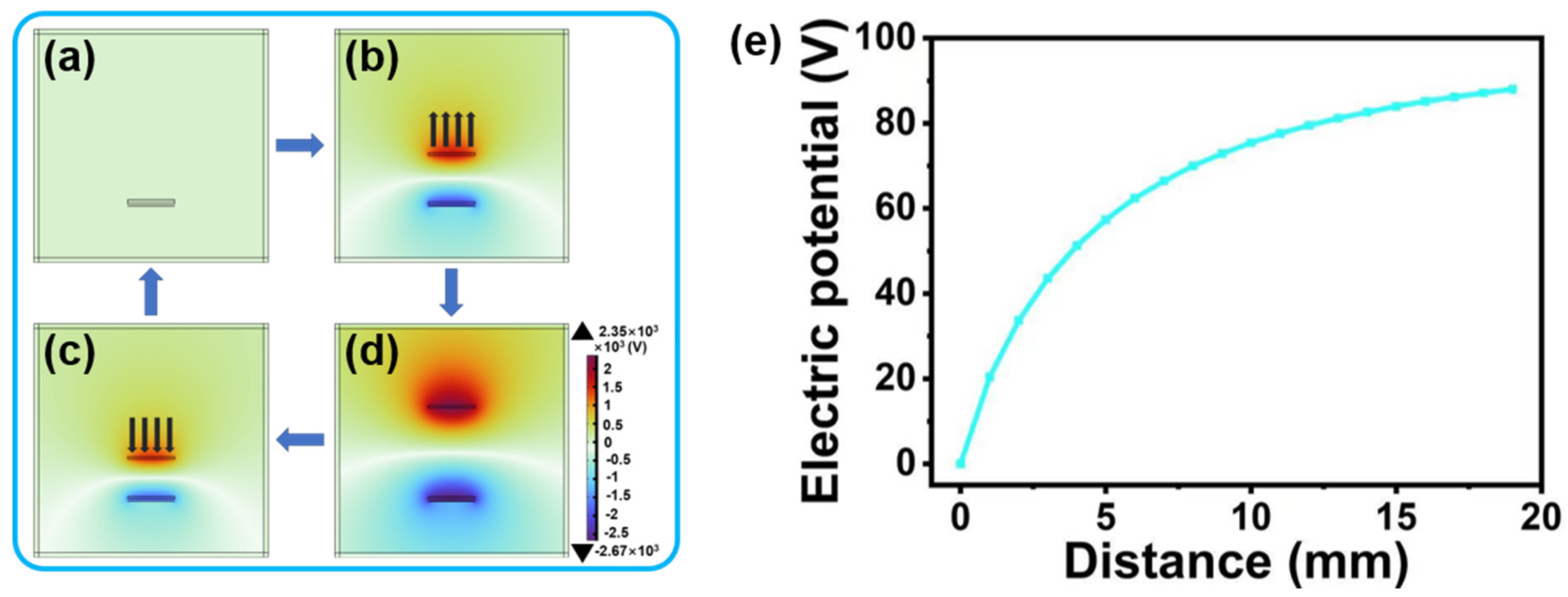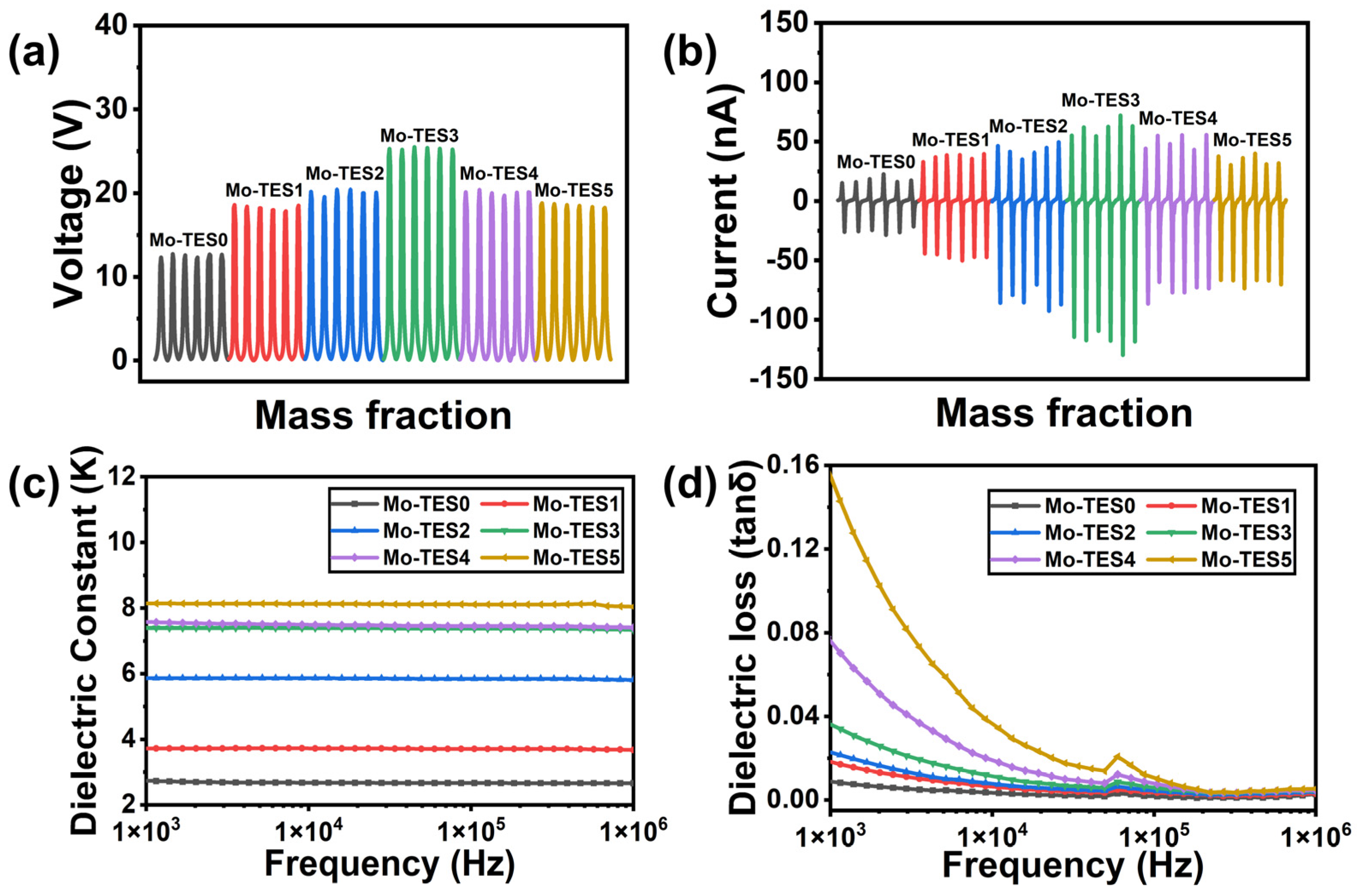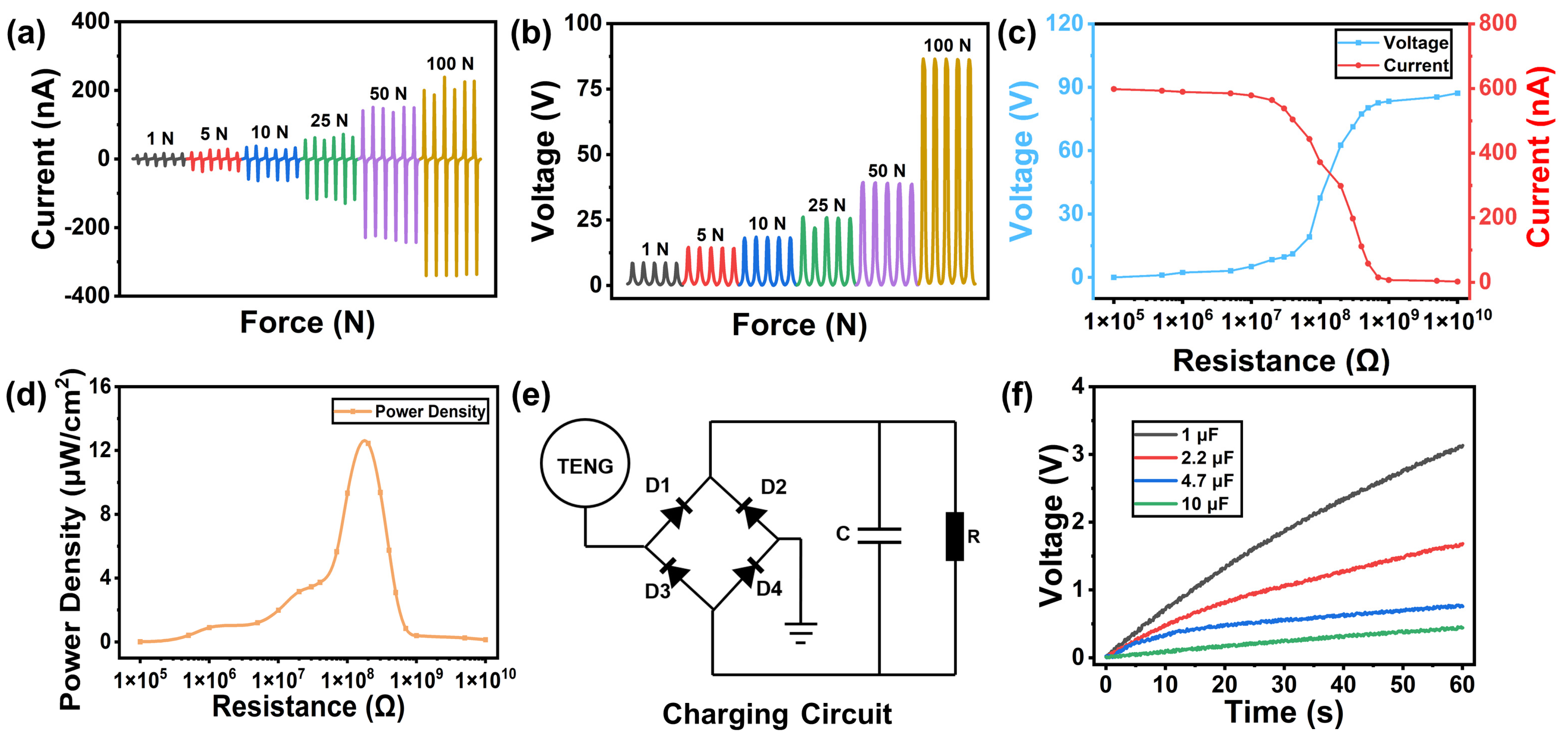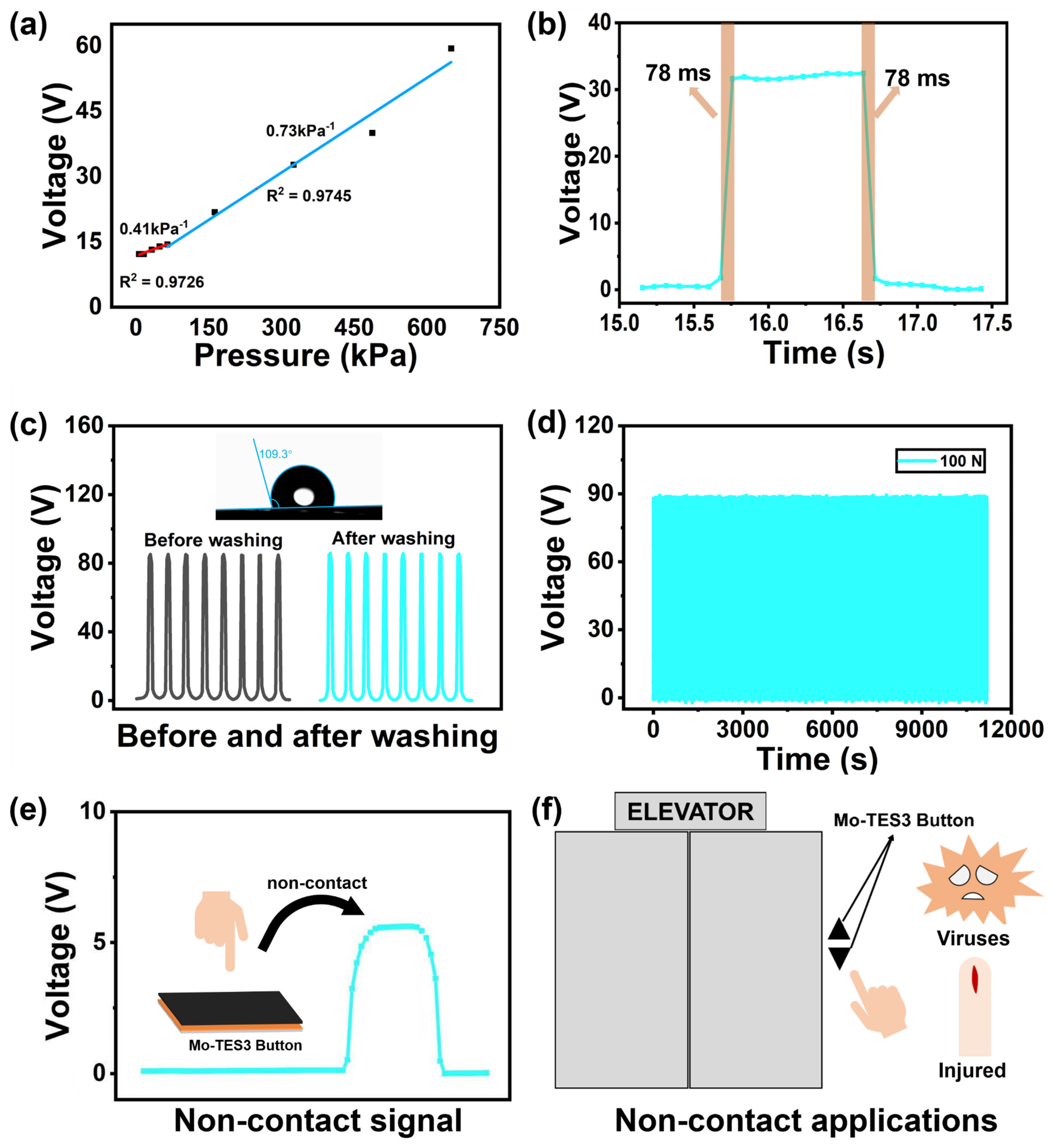Highly Sensitive and Stable Multifunctional Self-Powered Triboelectric Sensor Utilizing Mo2CTx/PDMS Composite Film for Pressure Sensing and Non-Contact Sensing
Abstract
:1. Introduction
2. Materials and Methods
2.1. Preparation of Mo2CTx
2.2. Preparation of Mo2CTx/PDMS Composite Films
2.3. Fabrication of Triboelectric Sensors Utilizing Mo2CTx/PDMS Composite Films
2.4. Characterization and Measurement
3. Results and Discussion
| Reference | Mode | Material | Size | Stresses | Frequency | Voltage | Power Density |
|---|---|---|---|---|---|---|---|
| [38] | Single electrode | Hydrogel | 20 mm × 20 mm | 0.67 kPa | 1 Hz | ≈71 V | - |
| [39] | Single electrode | CuNWs/PDMS | 20 mm × 20 mm | - | 2 Hz | ≈45 V | 13.4 μW/cm2 |
| [40] | Single electrode | Carbon fiber/PDMS | - | 50 N | 1 Hz | ≈72 V | 74.1 μW/cm2 |
| [41] | Single electrode | BaTiO3/PDMS | 30 mm × 30 mm | - | 1 Hz | 72.2 V | - |
| [42] | Single electrode | MXene/PDMS | - | 30 kPa | 3 Hz | ≈70 V | - |
| [43] | Single electrode | Graphene oxide/PDMS | - | 4 N | 4 Hz | 79.4 V | - |
| [44] | Single electrode | Copper foam/PDMS | - | 15 N | 3 Hz | ≈15 V | - |
| [45] | Single electrode | Fluorinated carbon black/PDMS | - | - | - | ≈60 V | - |
| This work | Single electrode | Mo2CTx/PDMS | 20 mm × 20 mm | 100 N | 1 Hz | 86.89 V | 12.45 μW/cm2 |
4. Conclusions
Supplementary Materials
Author Contributions
Funding
Data Availability Statement
Conflicts of Interest
References
- Dong, B.; Shi, Q.; Yang, Y.; Wen, F.; Zhang, Z.; Lee, C. Technology evolution from self-powered sensors to AIoT enabled smart homes. Nano Energy 2021, 79, 105414. [Google Scholar] [CrossRef]
- Zhao, X.; Askari, H.; Chen, J. Nanogenerators for smart cities in the era of 5G and Internet of Things. Joule 2021, 5, 1391–1431. [Google Scholar] [CrossRef]
- Gai, Y.; Jiang, Y.; Li, Z. Advances in health rehabilitation devices based on triboelectric nanogenerators. Nano Energy 2023, 116, 108787. [Google Scholar] [CrossRef]
- Shi, Q.; Zhang, Z.; Yang, Y.; Shan, X.; Salam, B.; Lee, C. Artificial Intelligence of Things (AIoT) Enabled Floor Monitoring System for Smart Home Applications. ACS Nano 2021, 15, 18312–18326. [Google Scholar] [CrossRef]
- Guan, M.; Liu, Y.; Du, H.; Long, Y.Y.; An, X.Y.; Liu, H.B.; Cheng, B.W. Durable, breathable, sweat-resistant, and degradable flexible sensors for human motion detection. Chem. Eng. J. 2023, 462, 142151. [Google Scholar] [CrossRef]
- Duan, Z.H.; Jiang, Y.D.; Zhao, Q.N.; Huang, Q.; Wsang, S.; Zhang, Y.J.; Wu, Y.W.; Liu, B.H.; Zhen, Y.; Tai, H.L. Daily writing carbon ink: Novel application on humidity sensor with wide detection range, low detection limit and high detection resolution. Sens. Actuators B Chem. 2021, 339, 129884. [Google Scholar] [CrossRef]
- Timon, C.M.; Hussey, P.; Lee, H.Y.W.; Murphy, C.; Rai, H.V.; Smeaton, A.F. Automatically detecting activities of daily living from in-home sensors as indicators of routine behaviour in an older population. Digit. Health 2023, 9. [Google Scholar] [CrossRef]
- Shen, Y.Y.; Yang, W.K.; Hu, F.D.; Zheng, X.W.; Zheng, Y.J.; Liu, H.; Algadi, H.; Chen, K. Ultrasensitive wearable strain sensor for promising application in cardiac rehabilitation. Adv. Compos. Hybrid Mater. 2023, 6, 21. [Google Scholar]
- Yang, J.C.; Gui, Y.A.; Wang, Y.F.; He, S.S. NiO/Ti3C2Tx MXene nanocomposites sensor for ammonia gas detection at room temperature. J. Ind. Eng. Chem. 2023, 119, 476–484. [Google Scholar] [CrossRef]
- Lu, Y.; Yue, Y.Y.; Ding, Q.Q.; Mei, C.T.; Xu, X.W.; Jiang, S.H.; He, S.J.; Wu, Q.L.; Xiao, H.N.; Han, J.Q. Environment-tolerant ionic hydrogel-elastomer hybrids with robust interfaces, high transparence, and biocompatibility for a mechanical-thermal multimode sensor. InfoMat 2023, 5, e12409. [Google Scholar] [CrossRef]
- Cattaneo, L.; Buonomo, A.R.; Iacovazzo, C.; Giaccone, A.; Scotto, R.; Viceconte, G.; Mercinelli, S.; Vargas, M.; Roscetto, E.; Cacciatore, F.; et al. Invasive Fungal Infections in Hospitalized Patients with COVID-19: A Non-Intensive Care Single-Centre Experience during the First Pandemic Waves. J. Fungi 2023, 9, 86. [Google Scholar] [CrossRef]
- Shi, H.T.; Zhang, H.P.; Wang, W.Q.; Zeng, L.; Sun, G.T.; Chen, H.Q. An Integrated Inductive-Capacitive Microfluidic Sensor for Detection of Wear Debris in Hydraulic Oil. IEEE Sens. J. 2019, 19, 11583–11590. [Google Scholar] [CrossRef]
- Shi, Y.Y.; Huang, F.L.; Wang, M.; Li, Y.H. A parallel ring-ring capacitive proximity sensor for detection of approaching conductor. Sens. Rev. 2023, 43, 359–368. [Google Scholar] [CrossRef]
- Li, G.; Chen, C.; Liu, Z.; Sun, Q.; Liang, L.; Du, C.; Chen, G. Distinguishing thermoelectric and photoelectric modes enables intelligent real-time detection of indoor electrical safety hazards. Mater. Horiz. 2024. [Google Scholar] [CrossRef] [PubMed]
- Fan, F.-R.; Tian, Z.-Q.; Lin Wang, Z. Flexible triboelectric generator. Nano Energy 2012, 1, 328–334. [Google Scholar] [CrossRef]
- Song, Y.D.; Wang, N.; Hu, C.S.; Wang, Z.L.; Yang, Y. Soft triboelectric nanogenerators for mechanical energy scavenging and self-powered sensors. Nano Energy 2021, 84, 105919. [Google Scholar] [CrossRef]
- Lai, Y.C.; Lu, H.W.; Wu, H.M.; Zhang, D.G.; Yang, J.Y.; Ma, J.; Shamsi, M.; Vallem, V.; Dickey, M.D. Elastic Multifunctional Liquid-Metal Fibers for Harvesting Mechanical and Electromagnetic Energy and as Self-Powered Sensors. Adv. Energy Mater. 2021, 11, 2100411. [Google Scholar] [CrossRef]
- Fu, X.F.; Pan, X.S.; Liu, Y.; Li, J.; Zhang, Z.J.; Liu, H.B.; Gao, M. Non-Contact Triboelectric Nanogenerator. Adv. Funct. Mater. 2023, 33, 2306749. [Google Scholar] [CrossRef]
- Zhou, Z.X.; Yuan, W.Z. Functionally integrated conductive organohydrogel sensor for wearable motion detection, triboelectric nanogenerator and non-contact sensing. Compos. Part A Appl. Sci. Manuf. 2023, 172, 107603. [Google Scholar] [CrossRef]
- Li, Z.; Xu, B.; Han, J.; Tan, D.; Huang, J.; Gao, Y.; Fu, H. Surface-modified liquid metal nanocapsules derived multiple triboelectric composites for efficient energy harvesting and wearable self-powered sensing. Chem. Eng. J. 2023, 460, 141737. [Google Scholar] [CrossRef]
- He, W.; Qian, Y.; Lee, B.S.; Zhang, F.; Rasheed, A.; Jung, J.E.; Kang, D.J. Ultrahigh Output Piezoelectric and Triboelectric Hybrid Nanogenerators Based on ZnO Nanoflakes/Polydimethylsiloxane Composite Films. ACS Appl. Mater. Interfaces 2018, 10, 44415–44420. [Google Scholar] [CrossRef]
- Li, E.; Pan, Y.M.; Wang, C.F.; Liu, C.T.; Shen, C.Y.; Pan, C.F.; Liu, X.H. Multifunctional and superhydrophobic cellulose composite paper for electromagnetic shielding, hydraulic triboelectric nanogenerator and Joule heating applications. Chem. Eng. J. 2021, 420, 129864. [Google Scholar] [CrossRef]
- Cai, Y.-W.; Zhang, X.-N.; Wang, G.-G.; Li, G.-Z.; Zhao, D.-Q.; Sun, N.; Li, F.; Zhang, H.-Y.; Han, J.-C.; Yang, Y. A flexible ultra-sensitive triboelectric tactile sensor of wrinkled PDMS/MXene composite films for E-skin. Nano Energy 2021, 81, 105663. [Google Scholar] [CrossRef]
- Bui, V.T.; Zhou, Q.T.; Kim, J.N.; Oh, J.H.; Han, K.W.; Choi, H.S.; Kim, S.W.; Oh, I.K. Treefrog Toe Pad-Inspired Micropatterning for High-Power Triboelectric Nanogenerator. Adv. Funct. Mater. 2019, 29, 1901638. [Google Scholar] [CrossRef]
- Yang, W.; Chen, H.M.; Wu, M.Q.; Sun, Z.Y.; Gao, M.; Li, W.J.; Li, C.Y.; Yu, H.L.; Zhang, C.; Xu, Y.; et al. A Flexible Triboelectric Nanogenerator Based on Cellulose-Reinforced MXene Composite Film. Adv. Mater. Interfaces 2022, 9, 2102124. [Google Scholar] [CrossRef]
- Yang, P.; Wang, P.F.; Diao, D.F. Graphene Nanosheets Enhanced Triboelectric Output Performances of PTFE Films. ACS Appl. Electron. Mater. 2022, 4, 2839–2850. [Google Scholar] [CrossRef]
- Zhang, H.; Zhang, D.-Z.; Wang, D.-Y.; Xu, Z.-Y.; Yang, Y.; Zhang, B. Flexible single-electrode triboelectric nanogenerator with MWCNT/PDMS composite film for environmental energy harvesting and human motion monitoring. Rare Met. 2022, 41, 3117–3128. [Google Scholar] [CrossRef]
- Gao, Y.Y.; Liu, G.X.; Bu, T.Z.; Liu, Y.Y.; Qi, Y.C.; Xie, Y.T.; Xu, S.H.; Deng, W.L.; Yang, W.Q.; Zhang, C. MXene based mechanically and electrically enhanced film for triboelectric nanogenerator. Nano Res. 2021, 14, 4833–4840. [Google Scholar] [CrossRef]
- Halim, J.; Kota, S.; Lukatskaya, M.R.; Naguib, M.; Zhao, M.Q.; Moon, E.J.; Pitock, J.; Nanda, J.; May, S.J.; Gogotsi, Y.; et al. Synthesis and Characterization of 2D Molybdenum Carbide (MXene). Adv. Funct. Mater. 2016, 26, 3118–3127. [Google Scholar] [CrossRef]
- Xu, H.J.; Dong, H.L.; Liu, X.T.; Qiao, H.; Chen, G.; Du, F.; Dall’Agnese, Y.; Gao, Y. High-Temperature Oxidized Mo2CTx MXene for a High-Performance Supercapacitor. ACS Appl. Mater. Interfaces 2023, 15, 53549–53557. [Google Scholar] [CrossRef]
- Zhu, G.; Peng, B.; Chen, J.; Jing, Q.; Lin Wang, Z. Triboelectric nanogenerators as a new energy technology: From fundamentals, devices, to applications. Nano Energy 2015, 14, 126–138. [Google Scholar] [CrossRef]
- Niu, S.; Wang, Z.L. Theoretical systems of triboelectric nanogenerators. Nano Energy 2015, 14, 161–192. [Google Scholar] [CrossRef]
- Harnchana, V.; Ngoc, H.V.; He, W.; Rasheed, A.; Park, H.; Amornkitbamrung, V.; Kang, D.J. Enhanced Power Output of a Triboelectric Nanogenerator using Poly(dimethylsiloxane) Modified with Graphene Oxide and Sodium Dodecyl Sulfate. ACS Appl. Mater. Interfaces 2018, 10, 25263–25272. [Google Scholar] [CrossRef] [PubMed]
- Liu, Y.; Han, R.; Li, L.; Zhou, Z.; Chen, G.; Li, Q. Tuning of Highly Dielectric Calcium Copper Titanate Nanowires To Enhance the Output Performance of a Triboelectric Nanogenerator. ACS Appl. Electron. Mater. 2020, 2, 1709–1715. [Google Scholar] [CrossRef]
- Zhang, H.; Zhang, P.; Li, P.; Deng, L.; Zhang, W.; Liu, B.; Yang, Z. Enhanced performance triboelectric nanogenerator based on porous structure C/MnO2 nanocomposite for energy harvesting. Nano Res. 2022, 15, 7163–7171. [Google Scholar] [CrossRef]
- Zhang, S.P.; Bhatta, T.; Rana, S.S.; Shrestha, K.; Pradhan, G.B.; Sharma, S.; Jeong, S.; Kim, H.S.; Park, J.Y. Noise-less hybrid nanogenerator based on flexible WPU and siloxene composite for self-powered portable and wearable electronics. Nano Energy 2024, 120, 109179. [Google Scholar] [CrossRef]
- Wang, Z.K.; Cui, J.; Liu, T.S.; Bai, S.M.; Hao, C.C.; Zheng, Y.Q.; Xue, C.Y. Composited PressureVelocity Sensor Based on Sandwich-Like Triboelectric Nanogenerator for Smart Traffic Monitoring. IEEE Sens. J. 2023, 23, 27872–27884. [Google Scholar] [CrossRef]
- Liu, Y.M.; Wong, T.H.; Huang, X.C.; Yiu, C.K.; Gao, Y.Y.; Zhao, L.; Zhou, J.K.; Park, W.; Zhao, Z.; Yao, K.M.; et al. Skin-integrated, stretchable, transparent triboelectric nanogenerators based on ion-conducting hydrogel for energy harvesting and tactile sensing. Nano Energy 2022, 99, 107442. [Google Scholar] [CrossRef]
- Li, G.Z.; Cai, Y.W.; Wang, G.G.; Sun, N.; Li, F.; Zhou, H.L.; Zhang, X.N.; Zhao, H.X.; Wang, Y.H.; Han, J.C.; et al. Performance enhancement of transparent and flexible triboelectric nanogenerator based on one-dimensionally hybridized copper/polydimethylsiloxane film. Nano Energy 2022, 99, 107423. [Google Scholar] [CrossRef]
- Barras, R.; Santos, A.D.; Calmeiro, T.; Fortunato, E.; Martins, R.; Aguas, H.; Barquinha, P.; Igreja, R.; Pereira, L. Porous PDMS conformable coating for high power output carbon fibers/ZnO nanorod-based triboelectric energy harvesters. Nano Energy 2021, 90, 106582. [Google Scholar] [CrossRef]
- Zhang, P.; Zhang, W.K.; Deng, L.; Zhang, H.H. A triboelectric nanogenerator based on temperature-stable high dielectric BaTiO3-based ceramic powder for energy harvesting. Nano Energy 2021, 87, 106176. [Google Scholar] [CrossRef]
- Shan, L.T.; Liu, Y.Q.; Zhang, X.H.; Li, E.L.; Yu, R.J.; Lian, Q.M.; Chen, X.; Chen, H.P.; Guo, T.L. Bioinspired kinesthetic system for human-machine interaction. Nano Energy 2021, 88, 106283. [Google Scholar] [CrossRef]
- Yang, C.R.; Ko, C.T.; Chang, S.F.; Huang, M.J. Study on fabric-based triboelectric nanogenerator using graphene oxide/porous PDMS as a compound friction layer. Nano Energy 2022, 92, 106791. [Google Scholar] [CrossRef]
- Zhang, M.; Jie, Y.; Cao, X.; Bian, J.; Li, T.; Wang, N.; Wang, Z.L. Robust design of unearthed single-electrode TENG from three-dimensionally hybridized copper/polydimethylsiloxane film. Nano Energy 2016, 30, 155–161. [Google Scholar] [CrossRef]
- Mu, J.L.; Song, J.S.; Han, X.T.; Xian, S.; Hou, X.J.; He, J.; Chou, X.J. Dual-Mode Self-Powered Rainfall Sensor Based on Interfacial-Polarization-Enhanced and Nanocapacitor-Embedded FCB@PDMS Composite Film. Adv. Mater. Technol. 2022, 7, 2101481. [Google Scholar] [CrossRef]






Disclaimer/Publisher’s Note: The statements, opinions and data contained in all publications are solely those of the individual author(s) and contributor(s) and not of MDPI and/or the editor(s). MDPI and/or the editor(s) disclaim responsibility for any injury to people or property resulting from any ideas, methods, instructions or products referred to in the content. |
© 2024 by the authors. Licensee MDPI, Basel, Switzerland. This article is an open access article distributed under the terms and conditions of the Creative Commons Attribution (CC BY) license (https://creativecommons.org/licenses/by/4.0/).
Share and Cite
Fan, J.; Wang, C.; Wang, B.; Wang, B.; Liu, F. Highly Sensitive and Stable Multifunctional Self-Powered Triboelectric Sensor Utilizing Mo2CTx/PDMS Composite Film for Pressure Sensing and Non-Contact Sensing. Nanomaterials 2024, 14, 428. https://doi.org/10.3390/nano14050428
Fan J, Wang C, Wang B, Wang B, Liu F. Highly Sensitive and Stable Multifunctional Self-Powered Triboelectric Sensor Utilizing Mo2CTx/PDMS Composite Film for Pressure Sensing and Non-Contact Sensing. Nanomaterials. 2024; 14(5):428. https://doi.org/10.3390/nano14050428
Chicago/Turabian StyleFan, Jialiang, Chenxing Wang, Bo Wang, Bin Wang, and Fangmeng Liu. 2024. "Highly Sensitive and Stable Multifunctional Self-Powered Triboelectric Sensor Utilizing Mo2CTx/PDMS Composite Film for Pressure Sensing and Non-Contact Sensing" Nanomaterials 14, no. 5: 428. https://doi.org/10.3390/nano14050428
APA StyleFan, J., Wang, C., Wang, B., Wang, B., & Liu, F. (2024). Highly Sensitive and Stable Multifunctional Self-Powered Triboelectric Sensor Utilizing Mo2CTx/PDMS Composite Film for Pressure Sensing and Non-Contact Sensing. Nanomaterials, 14(5), 428. https://doi.org/10.3390/nano14050428






